The 2015 Razer Blade Review
by Brett Howse on February 11, 2015 2:00 PM EST- Posted in
- Laptops
- Razer
- Razer Blade
- Notebooks
- GTX970M
Gaming Performance
The move to the GTX 970M should bring a substantial increase in graphics performance. Although the 2014 Blade was powerful, the GTX 870M could struggle if gaming at the native resolution of the panel. We will compare it against last year’s model at that resolution, as well as against other laptops in our standard gaming benchmarks.
We will start with our synthetic tests, and then move on to the game benchmarks.
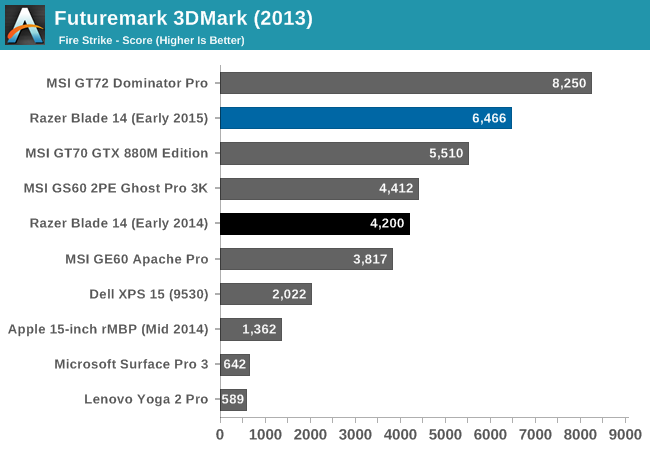
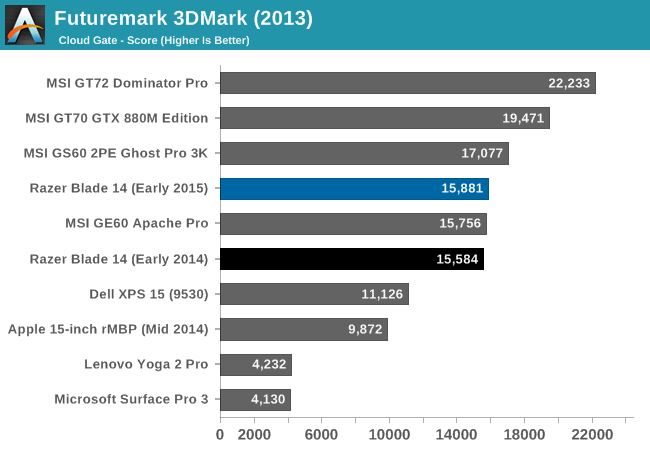

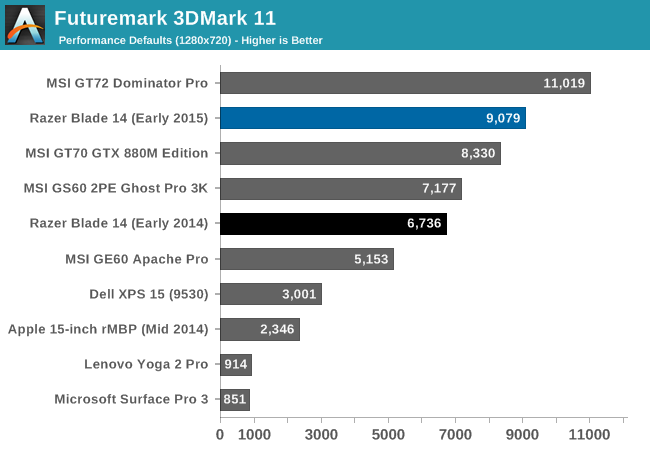
On the 3DMark tests, Fire Strike is the most potent. Here we see a 53% jump in performance over the 2014 Blade with 870M. We ran Cloud Gate several times, and could not get a better score. It is difficult to explain what is going on with that particular benchmark as it seems to be an outlier.
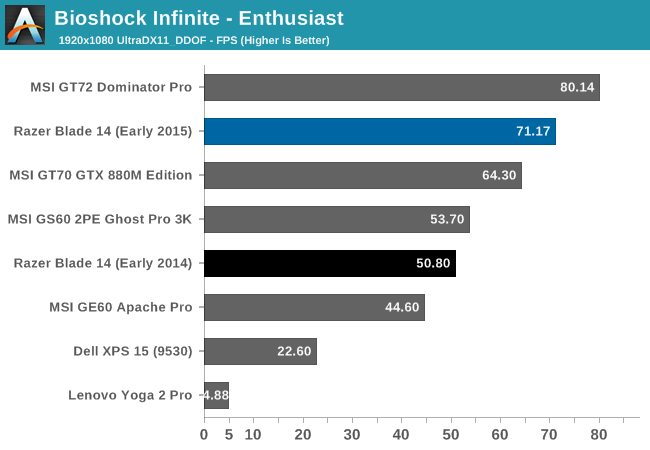
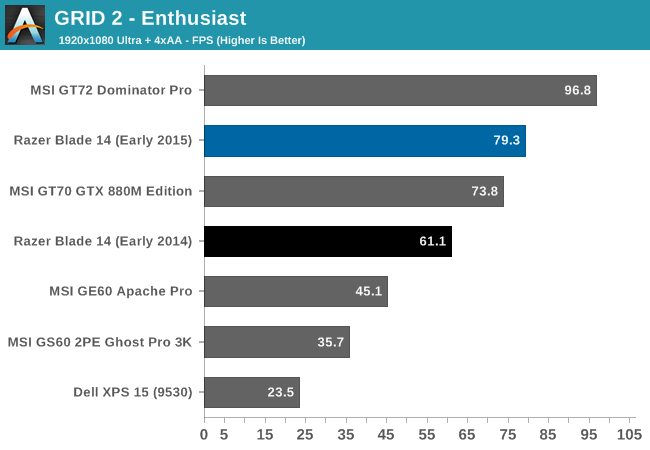
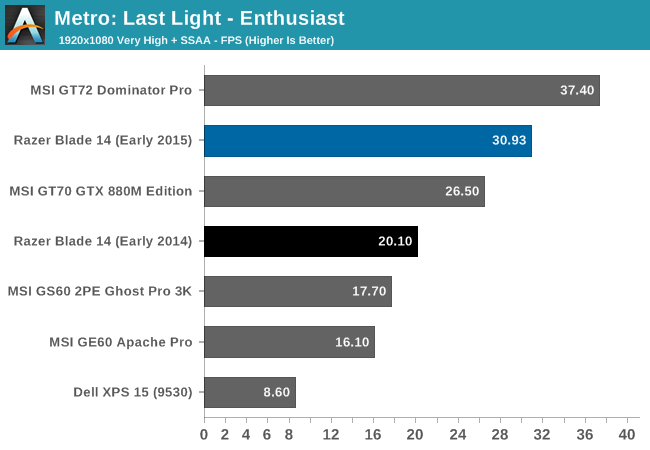
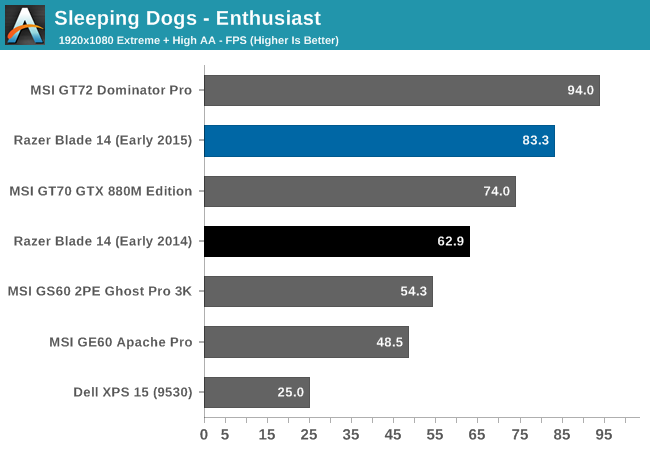
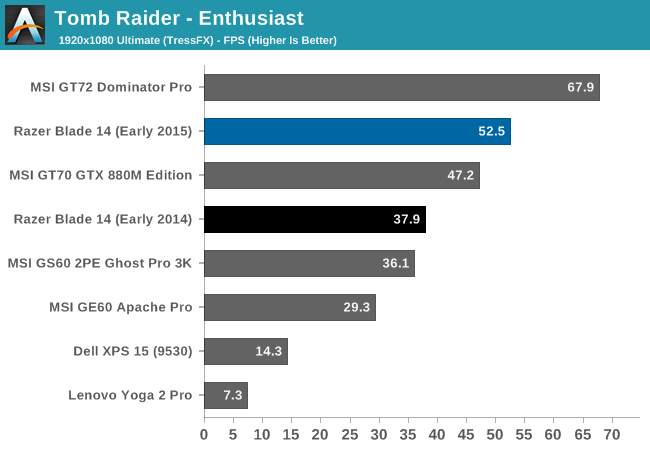
As you can see, the new CPU and GPU combination bumps up the performance quite substantially, with some of our real world benchmarks around 50% faster on the 2015 Blade. This is a good step over last year’s model in all of the tests. But, one area where the 2014 Blade could struggle was high resolution gaming. When you buy a laptop with a 3200x1800 display, you tend to want to take advantage of that if possible. We showed with last year’s model, that using the GeForce Experience menu, you could pretty easily achieve a balance of speed and features that would allow for gaming.
3200x1800 Gaming Testing
GeForce Experience on last year’s Blade gave us the following settings for Tomb Raider at 3200x1800.
This let us achieve a frame rate of 38.4 frames per second in the built in benchmark for Tomb Raider on last year's model. Certainly playable, especially in this genre of game, but not the 60+ FPS preferred for smoother gameplay. GeForce Experience does allow you to customize the framerate for performance versus quality, and we stuck with the default for 3200x1800.
Going through the GeForce Experience for the 2015 Blade actually resulted in a lower framerate. Our benchmark this year with the default 3200x1800 GFE was actually only 33.8 frames per second. However, due to the extra graphics power available, Post Processing was enabled by default for this year. Disabling Post Processing to get to the same settings as the 2014 Blade used resulted in just over 50 frames per second. Almost six million pixels is a lot of pixels to process, even for the latest single GPU mobile parts. However, if 50 frames per second is still not enough, you can easily adjust the slider towards performance and try again.
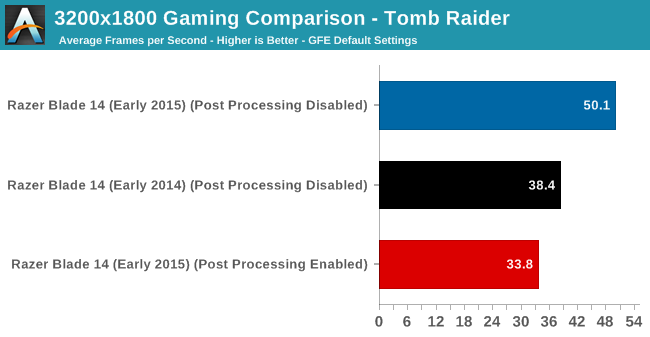
Really, to take this laptop to the next level for gaming, G-Sync would be a perfect fit since the GPU is plenty powerful, but could use a bigger safety net when the framerates do dip. This is not something we have seen officially on any laptops yet, but with the desktop monitors trickling out, it will only be a matter of time before it ends up in a laptop as well.
As a gaming laptop, this section is likely the most important to prospective buyers. The new CPU and GPU combo both add quite a bit more punch to the Razer Blade, and make for a better gaming experience at the high resolution of this display.


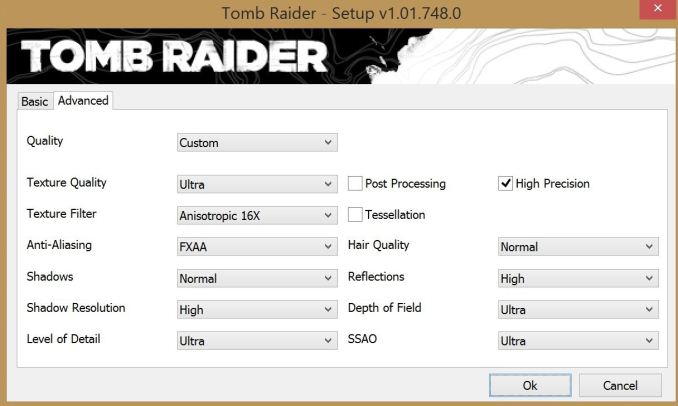








116 Comments
View All Comments
Jaisah - Thursday, September 3, 2015 - link
What is a "gimped" CPU? I have the 2.5 GHz i7 4870HQ turbo to 3.7GHz, it performs pretty well in all the tasks I've put it up to ;)dragonsqrrl - Wednesday, February 11, 2015 - link
Does anyone know how difficult it is to access the interior for a drive upgrade? At $200 for the 256, and an additional $300 for the 512, it's just not worth it to go with any of Razer's SSD upgrades. Might as well just go with the 128GB option and purchase a 512GB M.2 separately.lpjz290 - Wednesday, February 11, 2015 - link
If my memory serves me right, the 2015 model should feature a very similar back cover to the 2014 Blade, maybe this member-contributed iFixit teardown might provide some insight?https://www.ifixit.com/Teardown/Razer+Blade+14+%28...
dragonsqrrl - Thursday, February 12, 2015 - link
Actually looks pretty accessible based on the images.JoshHo - Wednesday, February 11, 2015 - link
I've bought the 2014 version, and in order to replace the SSD you need to remove the T4 torx screws on the bottom, remove the back cover, disconnect a display connector, two ribbon cables, and remove one Phillips screw to remove the SSD. It's a trivial task that takes around half an hour at most.dragonsqrrl - Thursday, February 12, 2015 - link
Thanks for the infoDanNeely - Thursday, February 12, 2015 - link
As fragile as connectors for laptop ribbon cables are, I wouldn't call any job that requires touching them trivial.hfm - Saturday, February 21, 2015 - link
http://forum.notebookreview.com/threads/cloning-th...Tunnah - Wednesday, February 11, 2015 - link
Although I agree that most people prefer HDMI over DP, I would argue that for a computer that can competently push 4K should have the ability to output it at 60hz.That aside, this is probably the first ever laptop I am seriously considering buying.
Uplink10 - Wednesday, February 11, 2015 - link
Does it have Mobile PCI Express Module (MXM) or is GTX 970M directly on motherboard?